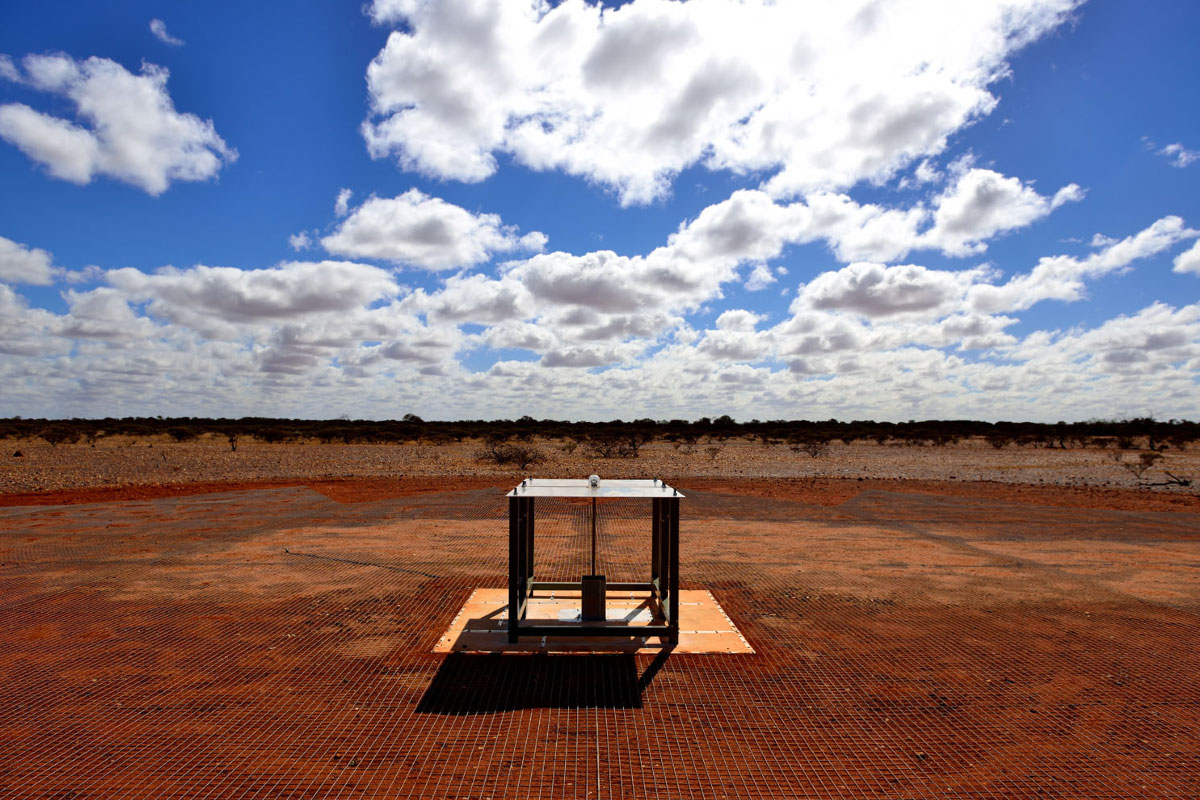A recent unexpected discovery suggests that the early universe looked quite different from what it was previously thought. Initial theories that say that dark matter is to blame for this discrepancy are criticized

News about the first stars in the universe always seem strange. Last July,
Renan Barkan , a cosmologist from Tel Aviv University, received an email from his longtime colleague,
Jad Bowman . Bowman runs a small group of five astronomers who built and commissioned a radio telescope in a remote part of western Australia. His goal - to detect the whisper of the first stars. Bowman and the team found an incomprehensible signal. And he asked Barkan to help him think about what exactly could have caused such a signal.
During all those years that radio telescopes scan the skies, astronomers hope to catch the faint signals of the first stars in the universe. Such objects are too dim, and at a distance of more than 13 billion light years are too far away to be distinguished by ordinary telescopes. Instead, astronomers are looking for traces of the effects of these stars on the gas surrounding them. Bowman’s equipment, like other telescopes, attempts to detect a specific dip in the radio wave graph from the far ends of the universe.
Such measurements are terribly difficult to make, because potential signals can be lost not only in a huge number of radio signals from modern society - this is one of the reasons why the experiment is located on the outskirts of Australia - but also in signals from nearby cosmic sources, such as our Milky Way Galaxy. And yet, after many years of methodical work, Bowman with colleagues and the EDGES experiment (an experiment to find traces of the global reionization era) concluded that they not only discovered the first stars, but also found evidence that the young cosmos was much colder than everyone thought.
Barkana was skeptical. “On the one hand, the measurements seemed to look reliable,” he said. “On the other hand, it was quite unexpected.”
What could make the early universe look cold? Barkana thought about all the possibilities and realized that this could be due to the presence of dark matter - a mysterious substance that fills the Universe, and at the same time eludes all attempts to understand what it is and how it works. He found that the results of EDGES can be interpreted as a completely new way of interaction between ordinary matter and dark matter.
The EDGES group
announced details about this signal and the discovery of the first stars in the Universe in the March issue of Nature. Together with the article was published the
work of Barkan, describing this new idea about dark matter. Media around the world smashed the news of the discovery. The Associated Press
wrote, “Astronomers caught a glimpse of the dawn of space when the stars were involved,” and added that “they may have discovered more mysterious dark matter at work.”
However, over the past since the publication of the week, cosmologists around the world have expressed a mixture of enthusiasm and skepticism. Researchers who saw the result of EDGES for the first time when he appeared in Nature conducted their own analysis and showed that even if dark energy of some kind, as suggested by Barkan, is responsible for it, only a very small part of it could have an impact. (Barkan himself took part in some of these studies.) Experimental astronomers said that although they respect the EDGES team and the careful work done by it, it is difficult to fully trust such measurements. "If this were not a revolutionary discovery, it would be much easier for people to believe in the results," said Daniel Price, an astronomer at Swinburne University of Technology in Australia, who is working on similar experiments. “Vivid statements require vivid evidence.”
This message has echoed in the cosmological community since the work appeared in the journal Nature.
Whisper source
The next day, after Bowman contacted Barkana and told him about the unexpected EDGES signal, Barkana went with his family to visit his wife's parents. During the trip, he says, he was thinking about the signal, telling his wife about an interesting puzzle that Bowman had told him.
Bowman with the EDGES team probed a neutral hydrogen gas that filled the universe for the first few million years after the Big Bang. This gas was prone to the absorption of light, which led to what cosmologists poetically called "dark ages." Although the cosmos was filled with diffused background light, the background radiation (RI) - the so-called afterglow of the Big Bang - this neutral gas absorbed it at certain wavelengths. EDGES was looking for this particular absorption pattern.
When stars began to turn on in the universe, their energy was to heat the gas. As a result, the gas reached a sufficiently high temperature and ceased to absorb the radiation sources. The absorption signals ceased and the dark ages ended.
The absorption signal, as measured by EDGES, contains a wealth of information. He stretched while moving the absorption pattern across the expanding universe. Astronomers can use this stretch to estimate how long the signal has been traveling, and therefore when the first stars came on. In addition, the width of the detected signal corresponds to the amount of time that the gas absorbed RI. And the intensity of the signal - the amount of absorbed light - is related to the temperature of the gas and the amount of light that was in space at that time.
Many researchers consider this last characteristic to be the most interesting. “This absorption turned out to be much stronger than we thought possible,” said Stephen Furlaneto, a cosmologist at the University of California at Los Angeles, who studied what EDGES data could mean for the formation of the earliest galaxies.
 The blue lines in the graph indicate the expected absorption force, according to different models. The red line shows the measured absorption.
The blue lines in the graph indicate the expected absorption force, according to different models. The red line shows the measured absorption.The most obvious explanation for the signal strength is that the neutral gas was colder than predicted, so it could absorb more RI. But how did the universe suddenly cool down? “We are talking about the time period in which the stars began to form,” said Barkana, “about the darkness before dawn. “So everything was as cold as possible.” The question is: What could be even colder? "
When he parked on the lawn of his wife's parents' house on that July day, an idea came to him: But could this be dark matter? After all, TM, apparently, does not interact with normal matter by means of electromagnetic force - it does not absorb or emit heat. So TM could initially be colder or cool much longer than normal matter at the beginning of the Universe, and then continue to cool.
For the next week, he worked on a theory of how a hypothetical form of TM called “
dark matter of microcharged particles ” could answer for this. Microcharged dark matter (MTM) could interact with ordinary matter, but only through weak interaction. The intergalactic gas could then cool, “in essence, simply by dumping heat into a sector of dark matter that is no longer visible,” Furlaneto explained. Barkana described this idea and sent it to Nature.
 Renan Barkana
Renan BarkanaThen he began working with this idea in more detail and with the help of colleagues. So did the other scientists. Immediately after the appearance of the work in Nature, several cosmological theorists began to compare the behavior of this unexpected type of TM with what we know about the Universe - decades of observations of the RI, data from supernova explosions, the results of collisions in particle accelerators such as the Large Hadron Collider, and understanding astronomers of how the Big Bang produced hydrogen, helium and lithium in the first few minutes of the Universe. If MTM was there and is it meaningful, do all these observations come about?
But nothing worked. More specifically, the researchers
found that MTM can only be a small fraction of the total number of TM in the Universe — too small to create the failure observed in EDGES data. “100% of TMs cannot interact in this way,” said
Anastasia Fialkov , an astrophysicist from Harvard University and the first author of the
paper sent to Physical Review Letters. Another work, the
preprint of which Barkan and his colleagues were sent to the site arxiv.org, argues that this percentage should be even lower - it cannot be more than 1-2% of the total number of MTM. Independent groups
have come to the same conclusions.
If this is not MTM, then what can explain the unexpected power of signal absorption with EDGES? Another possibility is the existence of additional background light at the beginning of the cosmos. If there were more radio waves in the early Universe than expected, then “the absorption would seem stronger, although the gas itself would remain the same,” Furlaneto said. Perhaps RI was not the only background light in the infancy of the universe.
And this idea is not so strange. In 2011, an experiment using a balloon,
ARCADE 2 ,
reported on the presence of a background radio signal that exceeded everything that could be expected from RI. Scientists cannot yet explain this result.
After the discovery of EDGES, several groups of astronomers reinterpreted the data. One group
studied the possibility of explaining data using BH, since they are the
brightest extragalactic sources of radio emission in the sky. However, BHs are also given by other types of radiation, for example, X-rays, which are not observed in the early Universe. Therefore, astronomers are skeptical about the idea that the BH may be a clue.
Is the signal real?
Perhaps the simplest explanation for what is happening is that the data is simply wrong. Measurements are extremely difficult. However, apparently, the EDGES team did everything possible to check and double-check their data — Price called the experiment “selective” —that means that if there is a flaw in the data, it will be extremely difficult to find.
 This antenna for the EDGES experiment was commissioned in 2015 in a remote place in Western Australia where there is virtually no radio interference
This antenna for the EDGES experiment was commissioned in 2015 in a remote place in Western Australia where there is virtually no radio interferenceThe EDGES team put its radio antenna into operation in September 2015. By December, they had already seen the signal, says
Raúl Monsalve , an experimental cosmologist at the University of Colorado at Boulder, and a member of the EDGES team. "We immediately treated him with suspicion, because he was stronger than expected."
So began their marathon of due diligence. They built a similar antenna and installed it 150 meters from the first one. They rotated antennas to eliminate the effects of the environment and tools. They used separate calibration and analysis techniques. “We conducted a lot of various tests and experiments to try to eliminate the likelihood that the signal comes from the environment or another source,” said Monsalve. - At first we did not believe ourselves. We thought that such a strong signal looks very suspicious, which is why it took us so much time to publish. ” They are convinced that they see the signal, and that the signal is unexpectedly strong.
“I believe in the result,” Price said, but he stressed that the data still needs to be checked for systematic errors. He mentioned one area where the experiment could in principle overlook an error: the sensitivity of any antenna depends on the observed frequency and direction of signal arrival. Astronomers can take these imperfections into account, either by measuring or modeling them. Bowman and colleagues decided to model them. Price suggests that members of the EDGES team instead find a way to measure them, and then re-analyze the signal, taking into account the measured effect.
The next step is to detect this signal on a different radio detector, which would mean that the signal comes from the sky, and not from an antenna or EDGES model. Scientists from the
LEDA project (Large-Aperture Experiment to Detect the Dark Ages - experiment with a large aperture to detect dark ages), located in California in the Owens Valley, are currently analyzing data from this tool. Then they will need to confirm that the signal has a cosmological nature, and is not produced somewhere in our Milky Way. This is not an easy task. The radio emission of our galaxy can be thousands of times stronger than cosmological signals.
In general, researchers refer to EDGES measurements and their interpretation with a healthy degree of skepticism, as Barkan and many others say. Scientists should be skeptical of the first of their kind measurements - this is how you can guarantee the reliability of observations, the accuracy of the analysis and the absence of errors in the experiment. That's the way science should work. “We ask questions, conduct research, rule out any wrong opportunities,” said Tomer Volanski, a specialist in particle physics from Tel Aviv University, who worked with Barkana on one of the works. - We seek out the truth. If the truth is that it is not TM, then it is not TM. ”